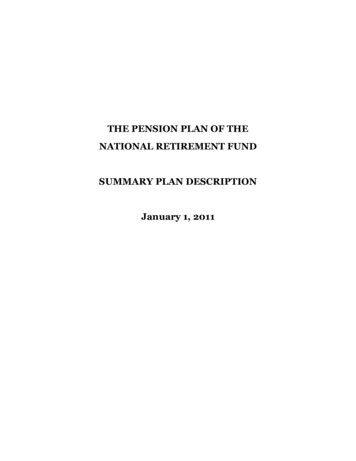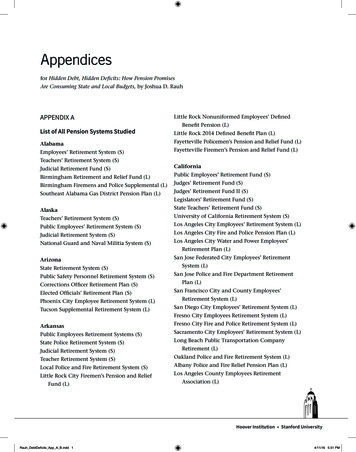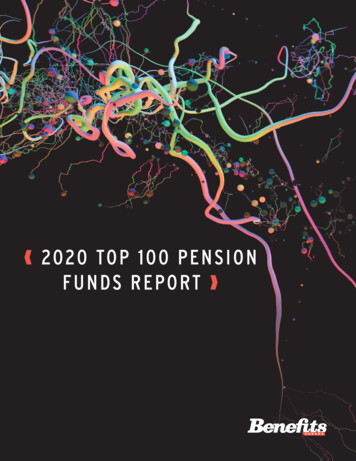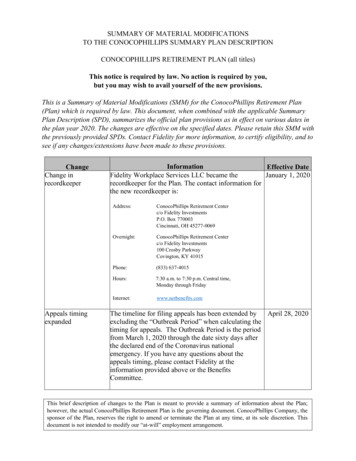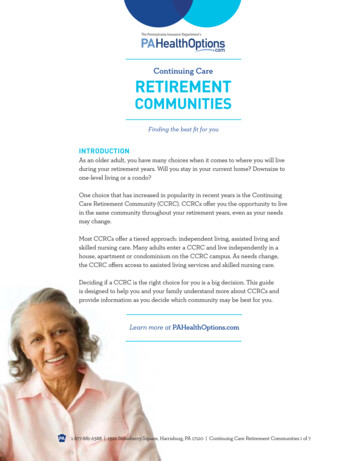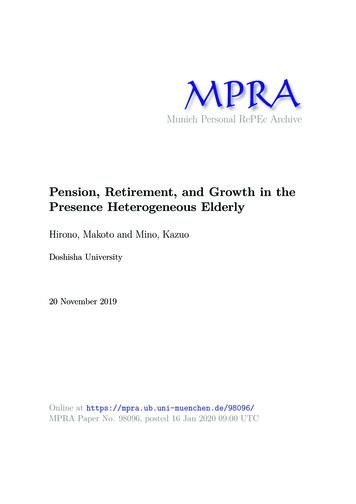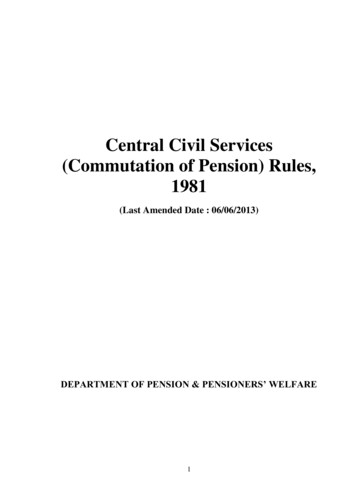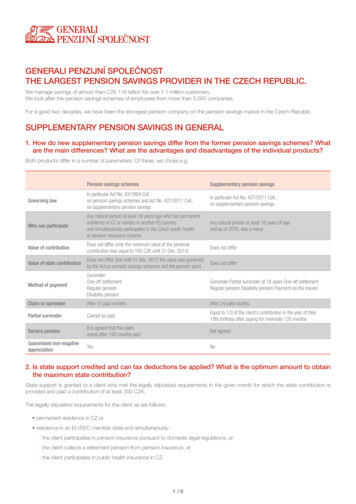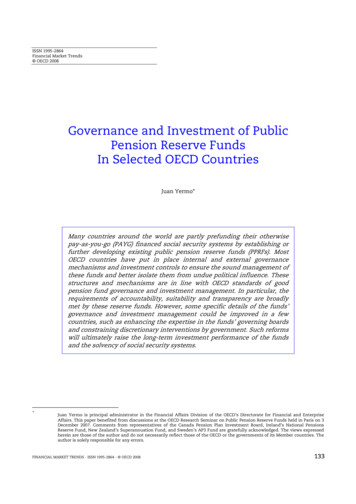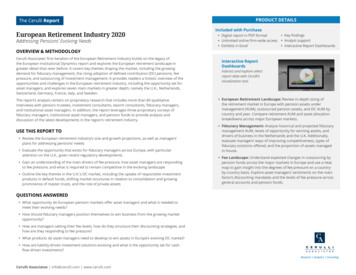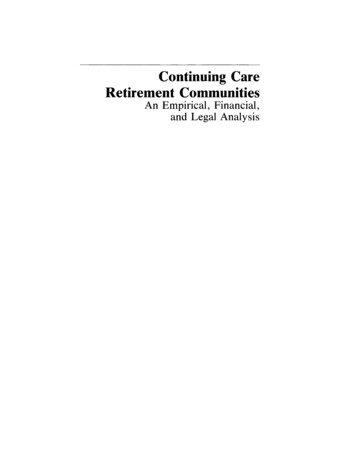
Transcription
Continuing CareRetirement CommunitiesAn Empirical, Financial,and Legal Analysis
Other publications of thePENSION RESEARCH COUNCILFundamentals of Private Pensions-Dan M. McGillConcepts of Actuarial Soundness in Pension Plans-Dorrance C. BronsonSocial Aspects of Retirement-Otto PollakPositive Experiences in Retirement-Otto PollakEnsuring Medical Care for the Aged-Mortimer SpiegelmanLegal Protection of Private Pension Expectations-Edwin W. PattersonLegal Status of Employee Benefit Rights under Private PensionPlans-Benjamin AaronDecision and Influence Processes in Private Pension Plans-James E.McNulty, Jr.Fulfilling Pension Expectations-Dan M. McGillCollectively Bargained Multi-Employer Pension Plans-Joseph J. MeloneActuarial Aspects of Pension Security- William F. MarplesStatus of Funding under Private Pension Plans-Frank L. Griffin, Jr. andCharles L. Trowbridge (out of print)Guaranty Fund for Private Pension Obligations-Dan M. McGillPreservation of Pension Benefit Rights-Dan M. McGillRetirement Systems for Public Employees-Thomas P. BleakneyEmployer Guarantee of Pension Benefits-Dan M. McGillReciprocity among Private Multiemployer Pension Plans-Maurice E.McDonaldA New Look at Accounting for Pension Costs- William D. Hall and DavidL. LandsittelSocial Security and Private Pension Plans: Competitive orComplementary?-Dan M. McGill (ed.)Pension Mathematics-Howard E. Winkle vossIndexation of Pension and Other Benefits-Robert J. MyersJoint Trust Pension Plans-Daniel F. McGinnFinancing the Civil Service Retirement System-Dan M. McGill (ed.)Social Investing-Dan M. McGill, (ed.)
Continuing CareRetirement CommunitiesAn Empirical, Financial,and Legal AnalysisHoward E. WinklevossSenior Vice PresidentJohnson & HigginsAdjunct Associate Professorof Insurance and Actuarial ScienceWharton SchoolAlwyn V. PowellAssistant Professor ofActuarial Science and InsuranceGeorgia State Universityin collaboration withDavid L. Cohen, Esq.AssociateBallard, Spahr, Andrews & IngersollAnn Trueblood-RaperConsultant in Gerontology1984Published for thePension Research CouncilWharton SchoolUniversity of PennsylvaniabyRICHARD D. IRWIN, INC. Homewood, Illinois 60430
To our children:Amanda, Cameron, & TylerandThandi & Sibongile 1984 by thePension Research Councilof theWharton SchoolUniversity of PennsylvaniaAll Rights ReservedISBN 0-256-03125-8Library of Congress Catalog Card No. 83-81175Printed in the United States of America1 2 3 4 5 6 7 8 9 0 M P 1·0 9 8 7 6 5 4
PENSION RESEARCH COUNCILDan M. McGill, Chairman and Research DirectorChairman, Insurance DepartmentThe Wharton School of the University of PennsylvaniaJ. Vance Anderson, Counsel for Employee Relations, Mobil OilCorporation, New York CityPreston C. Bassett, F.S.A., Consulting Actuary, Wallingford, PennsylvaniaKenneth Blaylock, President, American Federation of GovernmentEmployees, Washington, D.C.Edwin F. Boynton, F.S.A., Vice President and Consulting Actuary, TheWyatt Company, Washington, D.C.Laurence E. Coward, F.C.I.A., Executive Vice President and Director,William M. Mercer, Ltd., TorontoHarrison Givens, F.S.A., Senior Vice President, Equitable Life AssuranceSociety of America, New York CityDonald S. Grubbs, Jr., F.S.A., Consulting Actuary, George B. BuckConsulting Actuaries, Washington, D.C.Russell H. Hubbard, Jr., Esq., Corporate Employee Relations, GeneralElectric Company, Fairfield, ConnecticutG. David Hurd, Vice President, Bankers Life Company, Des MoinesRaymond C. Lauver, Partner, Price, Waterhouse, New York CityGeorge M. Lingua, Executive Vice President, Citibank, N.A., New YorkCityAlicia H. Munnell, Vice President and Economist, Federal Reserve Bank ofBostonRoger F. Murray, Emeritus Professor of Banking, Columbia University,Wolfeboro, New HampshireRobert J. Myers, F.S.A., Former Chief Actuary, Social SecurityAdministration, Silver Spring, MarylandJames E. Pesando, Professor of Economics, University of TorontoTherese F. Pick, Director, Benefits Administration & Gen. PersonnelPractices, AT&T, Morristown, New JerseyJerry S. Rosenbloom, Professor of Insurance, University of Pennsylvania,PhiladelphiaL. Edwin Wang, Administrator, Board of Pensions of Lutheran Church inAmerica, MinneapolisRandolph W. Westerfield, Professor of Finance, University ofPennsylvania, PhiladelphiaHoward E. Winklevoss, Adjunct Associate Professor of Insurance,University of Pennsylvania, PhiladelphiaHoward Young, F.S.A., Director of Social Security Department, UnitedAutomobile Workers, Detroitv
PURPOSE OF THE COUNCILThe Pension Research Council was formed in 1952 in response to an urgentneed for a better understanding of the private pension mechanism. It is composed of nationally recognized pension experts representing leadership inevery phase of private pensions. It sponsors academic research into the problems and issues surrounding the private pension institution and publishes thefindings in a series of books and monographs. The studies are conducted bymature scholars drawn from both the academic and business spheres.
ForewordThose familiar with the interests and past activities of the PensionResearch Council may be surprised that it is publishing a book oncontinuing care retirement communities. Over the years, the Councilhas been concerned principally with the actuarial and financial soundness of pension plans and the protection of the rights of individualswho look to them as a source of old-age financial support. In otherwords, the Council has traditionally sponsored research with the underlying purpose of strengthening those mechanisms designed to provide the financial resources needed for a secure old age. In contrast,this book is concerned with a relatively recent institutional arrangement that seeks to provide old-age security and health care in kind.Almost from the moment The Commonwealth Fund and the RobertWood Johnson Foundation approved a grant to the Wharton School tostudy continuing care retirement communities, the Council expressedan interest in reviewing the findings of the study, with a view toward itspublication. The sponsors of the project had the same concerns aboutthis new institution that the Pension Research Council has about thepension institution-its ability to deliver the benefits and servicespromised. The nature of the arrangement raises questions about itsactuarial soundness, financial stability, and protection of members'rights.The author of this Foreword participated in the study in an oversightcapacity and was in a position to judge the quality of the researchinvolved. The project director, Dr. Howard E. Winklevoss, a memberof the Wharton School faculty and the Council, kept the Council fullyapprised of developments and of progress being made on the project.The final draft of the report was reviewed by members of the Counciland by the project's advisory committee-who recommended publication by the Council, if permissable. The project sponsors (The Commonwealth Fund and the Robert Wood Johnson Foundation) suggestedseveral guidelines for selecting an entity to publish the study results butleft the choice to the dean of the Wharton School. On the basis of hisknowledge of and confidence in the Pension Research Council, DeanDonald C. Carroll designated the Council to publish the study.The Council is proud to publish the results of this pioneering study.The study and its recommendations should be a constructive influenceon the future growth of this new social organism, embodying an innovative approach to old-age financial security.The Council extends its congratulations to The CommonwealthFund and the Robert Wood Johnson Foundation for conceiving thisproject, and it expresses its profound gratitude to them for making thenecessary financial resources available.ix
xFunds for the publication of this volume were drawn from the RalphH. Blanchard Memorial Endowment of the Pension Research Council.Mr. Blanchard was one of the founders of the organization now knownas the National Health and Welfare Mutual Life Insurance Association, which provides pension and insurance facilities for the staffs ofsocial welfare agencies. Mr. Blanchard served as president of the organization for 14 years, and at the time of his death in 1972 he washonorary president. The Memorial Endowment was established andfunded by the NHW Mutual Life Insurance Association to perpetuatethe memory of Mr. Blanchard and to further the social goals to whichhe was so deeply committed. The subject matter of this study epitomizes the concern for the elderly that occupied the thoughts and energy of Mr. Blanchard throughout his life.It should be understood, of course, that the statements made and theviews expressed in this volume are solely the responsibility of theauthors and should not be attributed to the funding agencies.Dan M. McGill
PrefaceToday there are about 275 continuing care retirement communities(CCRCs) in the United States where some 90,000 elderly people (average age about 80) live independently in their own apartments but havethe opportunity for eating together, group recreation, and other activities that comes from being part of an organized community. Mostimportant, in addition to having immediately available a variety ofhealth and social services which they can call on according to theirdesires and needs, the residents have a virtual guarantee that they willbe adequately taken care of no matter what happens to their health.The fear of someday being a burden on relatives or friends or of findingoneself helpless among uncaring strangers is effectively removed.It is this health care guarantee that principally distinguishes CCRCsfrom other retirement communities. CCRCs provide insurance againstthe cost of long-term care, and supplement coverage of acute healthcare costs paid for largely by Medicare and private insurance. Theirunique feature is that they provide this otherwise unobtainable fullinsurance in combination with independent living arrangements thatthe resident can enjoy as long as health permits.CCRCs are intended to be fully self-supporting, and therein lies theorigin of this book. The study is the first detailed analysis of the actuarial, financial, and legal issues involved in keeping existing CCRCs financially sound and providing for the formation of new communities inways that protect the rights of residents while assuring the perpetuation of the community.CCRCs provide essentially a new form of insurance, but until nowthis type of insurance has not been subjected to rigorous examination.It is fortunate that such an examination has begun, and it is to be hopedthat this book will be followed quickly by other work in the field. Themembers of the Advisory Committee who worked closely with theresearch team believe that the CCRC field may be on the threshold of amajor expansion, principally because for the first time large numbers ofolder Americans will be able to meet the cost.The financing method combines a sizable entrance fee (average 35,000 single and 39,000 couple at the time of the study) with amonthly payment which is adjusted from time to time for inflation andoccasionally other factors (average 600 single and 850 couple).About 70 percent of older people now own their homes, and in manycases they have enough equity in those homes to meet the requiredentrance fees. And inflation-proof Social Security plus some additionalincome from private pensions and investments can form a basis formeeting the monthly fee for many older people, although undoubtedlyconsiderably less than a majority.xi
xiiIt is true that many who can afford CCRCs will nevertheless preferother retirement arrangements, but for a considerable number the fullhealth insurance, including long-term care, combined with independentliving in a community setting will make CCRCs attractive.On behalf of the other 12 members of the Advisory Committee, Iwish to commend the research team-Howard E. Winklevoss, Ph.D.,project director; Alwyn V. Powell, MAAA; David L. Cohen, Esq.;Ann Trueblood-Raper; and Amy R. Karash-for their efforts to address the comments and suggestions of the Advisory Committeethroughout the past 18 months and for diligently pursuing the researchwhich has produced this book. We also wish to thank Dr. Dan M.McGill, who served the study as consultant to the research team and aschairman of the Wharton School Insurance Department and the Pension Research Council.It is our hope that the book will be useful to public policymakers, tocorporations and foundations with an interest in older people and theirhealth, to the financial community, and to potential sponsors ofCCRCs.The Robert Wood Johnson Foundation of Princeton and The Commonwealth Fund of New York City provided financial support for thework of the research team and the Advisory Committee. We are grateful for their backing and hope that the philanthropic community willcontinue to support important research on CCRCs and related topics.Robert M. BallChairman of the Advisory CommitteeContinuing Care Retirement Community Study
Authors' PrefaceNearly four years have passed since we completed our first comprehensive actuarial study of a continuing care retirement community(CCRC). At that time, the application of actuarial science to set fees inthis growing field was nonexistent. Most of the assumptions andmethodologies used to set fees and establish financing were not basedon scientific analysis but instead were rules of thumb or anecdotalapproaches. Moreover, the literature about the industry dealt withsocial and health-related issues, and rarely with the financial issuesassociated with operating a facility.To some degree, the limited financial sophistication was due to thenewness of the concept and a misconception regarding its true nature.Many of the early marketing efforts concentrated on the real estatecomponent of the services provided. The central theme of providing away to finance long-term health care needs privately was a secondaryand rarely emphasized issue. Actuaries and other financial analystswere basically unaware of this industry prior to publicity about thefinancial distress of some communities that made national headlines inthe late 1970s. Even then, there was considerable controversy over thecorrect pricing methodologies and the appropriate types of contractualguarantees. It was even suggested that the continuing care financingarrangement to ensure lifetime health care for small groups of elderlywas not viable, or was possible only with fees that were prohibitivelyexpensive.Recognizing that the service goals of the continuing care conceptmay be one answer to the growing needs of the independent elderly forhousing and health care, the Robert Wood Johnson Foundation andThe Commonwealth Fund solicited proposals to conduct research toaddress the question of financial viability for the concept. In April1981, they agreed to fund jointly a research grant to the WhartonSchool of the University of Pennsylvania, with Howard E. Winklevoss, Ph.D., and Alwyn V. Powell, MAAA, as the primary investigators. So that the research would be timely, the authors decided toconcentrate on the following three areas: (1) a definition and survey ofthe general characteristics of the CCRC industry, (2) a detailed development and explanation of the actuarial principles underlying the pricing and long-term financial characteristics of CCRCs, and (3) a discussion of the legal issues arising from the continuing care contract withsuggestions for their legislative treatment.This book is the culmination of 18 months of research. Its primaryobjectives are to set forth normative guidelines for pricing and evaluating continuing care retirement communities and to provide a referencethat will assist legislators in assessing the advantages and disadvanxiii
xivtages of various components of continuing care regulation. This book isnot designed as a "how-to" book on the financial operation of CCRCs;rather, it is intended to provide the management and board members ofCCRCs with a broad understanding of the financial intricacies of theircommunities. Furthermore, this book provides guidelines to analystswho wish to conduct similar research by explaining in detail the methodologies developed during the course of the study.Chapter 1 presents an overview of the industry's growth and explains why the industry is worthy of research; the rest of the book isdivided into three parts, corresponding to the study's three researchtopics. Part One consists of Chapters 2 and 3, which summarize theempirical findings of the survey of 207 CCRCs (75 percent of the defined universe). Part Two consists of Chapters 4 through 11, which willinterest those readers whose concerns embrace financial issues. Thesechapters develop the actuarial methodology proposed for evaluatingthe long-term financial condition of a CCRC. The results of applyingthis methodology to six existing CCRCs are discussed in each of thechapters. Part Three consists of Chapters 12 and 13. Chapter 12 discusses relevant legal issues and how they are treated by existing legislation. Chapter 13 presents the authors' recommendations for statelevel legislation on each of these issues. Finally, Chapter 14summarizes the significant research findings and recommendations andsuggests a number of areas that merit further research. The appendixescontain technical explanations of the methodologies developed by theauthors.We would like to offer thanks to the members of the study's Advisory Committee, who reviewed all preliminary drafts of the book andattended 11 days of seminars to guide the research staff in the conductof the study. Other valuable advice was contributed by members of thereview panel, which consisted of providers of continuing care and legalexperts practicing in the field; the members of both groups are listed onthe following pages. Several members of the Pension Research Councilalso offered their comments prior to publication, and Dr. Dan M.McGill, chairman of the Pension Research Council, is owed specialthanks for his review of the book and for his helpful guidance throughout the study.()III' collahorators made important contributions to this volume.TIIl'Y inl'ludc Ann Truehlood-Raper, consultant in gerontology, whowwt\· ('Imrtcr, 2 and : David L. Cohen. Esq . associate at Ballard,SpllllI, An,ln'w" ,IV. Inttcrsoll, who researched and wrote Chapters 12n",1 I'; 01 MlllwII A. I.l'Itcn, associate professor of insurance andh""llh nm' 'I y . I\·"' . , who l'lllllrihlltcd to Chapter 10; and MitchellI."u", I,uhh,,' .dllllon . ",on,,"llant, who contrihuted to Chapter 1.W\, III" 1II11I\'1'lIlllIlh\' A",\· . k'an Association of Homes for the Aging1'\11 1\'1 II . hI linn' in ,kvl'lorintt ollr 24-page survey instrument, for
Authors' Prefacexvencouraging its members to complete the instrument, and for its helpfulcomments and support.The authors are particularly indebted to the following staff members, whose collective contributions were essential for the timely completion of this project: Robert Goodrich; Roger W. Hallowell; JosephMarant; Jayaram Muthuswamy; and Catherine C. Singer. We extendour special thanks to Amy R. Karash, our administrator, who plannedthe logistics associated with the survey questionnaire, word-processedand edited innumerable versions of the book, and provided day-to-daysupport from the inception of the study.Finally, and most important, we are grateful to our wives, Carol andKeitumetse, whose encouragement and acceptance of additional responsibilities during the course of the study enabled us to devote ourtime to the research and writing of this book.Naturally, the authors remain solely responsible for any conceptualor technical errors that may remain.Howard E. WinklevossAlwyn V. Powell
UNIVERSITY OF PENNSYL VANIACONTINUING CARE RETIREMENT COMMUNITY STUDYADVISORY COMMITTEERobert M. Ball, Author and Lecturer, Former Commissioner of SocialSecurity, Washington, D.C.James W. Cater, Jr., Executive Director, Presbyterian Homes of the Synodof Florida, Winter Park, FloridaDavid C. Crowley, Former Executive Vice President, American Associationof Homes for the Aging, Washington, D.C.Hon. Thomas M. Jenkins, Judge, Superior Court of the County of SanMateo, Redwood, CaliforniaLloyd W. Lewis, Executive Director, Kendal at Longwood, Kennett Square,PennsylvaniaDonald L. Moon, Executive Director, Foulkeways at Gwynedd, Gwynedd,PennsylvaniaJohn A. Murdock, Associate General Secretary, Health & WelfareMinistry, United Methodist Church, New York CityDale Neuhaus, Partner, Ernst & Whinney, Cleveland, OhioDoris Schwartz, Senior Fellow, School of Nursing, University ofPennsylvania, Resident, Foulkeways at Gwynedd, Gwynedd,PennsylvaniaWalter Shur, Executive Vice President & Chief Actuary, New York LifeInsurance Company, New York CityDr. Bruce VIadeck, Assistant Secretary, Department of Health, State ofNew Jersey, Trenton, New JerseyDr. Stanley S. Wallack, Director, University Health Policy Consortium,Brandeis University, Waltham, MassachusettsDr. T. Franklin Williams, Medical Director, Monroe Community Hospital,Rochester, New Yorkxvi
UNIVERSITY OF PENNSYLVANIACONTINUING CARE RETIREMENT COMMUNITY STUDYREVIEW PANELNils G. Axelson, President, The Evangelical Covenant Church of America,ChicagoByron M. Baker, Administrator, The Hearthstone, Seattle, WashingtonJoseph E. Becker, Administrator, Masonic Home of New Jersey,Burlington, New JerseyNathan Bushnell III, Administrator, Westminster Canterbury House,Richmond, VirginiaCharles K. Dilgard, Administrator, Otterbein Home, Lebanon, OhioStewart Entz, Legal Affairs Director, Kansas Association of Homes for theAging, Topeka, KansasEugene T. Hackler, Senior Partner, Hackler, Londerholm, Corder Martin &Hackler, Olathe, KansasRobert B. Haldeman, Partner, Semmes, Bowen & Semmes, Baltimore,MarylandNorman E. Harper, Executive Vice President, Loretto Geriatric Center,Syracuse, New YorkGarret M. Heher, Partner, Smith, Stratton, Wise & Heher, Princeton, NewJerseyRev. A. J. Hoeger, President, The Evangelical Lutheran Good SamaritanSociety, Sioux Falls, South DakotaGeorge Hulse, Chairman, Board of Directors, John Knox Village, Lee'sSummit, MissouriRalph Knight, President, Northern California Presbyterian Homes, Inc., SanFrancisco, CaliforniaLarry L. Laird, Executive Vice President, Life Care Services Corporation,Des Moines, IowaM. E. McPherson, President, Episcopal Homes Foundation, Lafayette,CaliforniaJames Muzzey, Vice President, Finance, Northern California PresbyterianHomes, San Francisco, CaliforniaTed Radamaker, Administrator, Mount San Antonio GardensCongregational Homes, Inc., Pomona, CaliforniaRev. Albert L. Schartner, President, Presbyterian Homes, Inc., Dillsburg,PennsylvaniaJohn W. Sloan, Vice President, B. C. Ziegler and Company, West Bend,WisconsinD. Martin Trueblood, Executive Director, Broadmead, Cockeysville,MarylandH. John Vanderbeck, President, National Housing, Retirement Ministries,Valley Forge, Pennsylvaniaxvii
xviiiRev. R. Arthur Wagner, President, Methodist Manor, Inc., West Allis,WisconsinPaul White, President, Philadelphia Presbyterian Homes, Inc., Wayne,PennsylvaniaEllis G. Willard, President, The Presbyterian Homes of New Jersey,Princeton, New Jersey
ContentsList of Tables, xxiiiList of Figures, xxvii1. Introduction, 1Economic Issues. The Challenge of an Aging Society. Choices in Shelterand Services. Financing of Long-Term Care. History and Growth ofCCRCs. Characteristics of CCRCs: Potential Problems. Overview ofChapters.Part OneEmpirical Analysis, 192. An Empirical Survey of CCRCs I, 11Institutional Definition: Types of Housing. Contract. Health Care Guarantee. Geographic Location. Organization, Affiliation, and Tax Status.Contract Provisions: Probationary Period. Contract Termination Policies. Fees: Entry Fees. Entry Fee Increases. Amortization of Entry Fees.Monthly Fees. Monthly Fee Increases. Health Care Fees. Double-Occupancy Fees. Financial Aid. Refunds: Refunds upon Death. Refunds uponTermination by Community.3. An Empirical Survey of CCRCs II, 46Resident Population. Health Care Utilization: Nursing Care and HealthCare Ratios. Policy on Moving Residents to Health Care. Outside Admission to Health Care. Nurse Care Certification by Medicare and Medicaid. Services and Special Features: Categorized Services. Health CareGuarantee/Service Analysis. Regional Variation in Services Offered.Community Age/Service Analysis. Fees and Service Package. Number ofMeals. Special Features. Management and Financial Policies: PurchasedManagement Services. Aggregate Expenses. Financial Statements. Admission Policies. Outside Admission to Nursing Care. Residents' Role inDecision Making. Capital Financing. Reserves: Debt Service Reserve.Equipment Replacement Reserve. Health Care Reserve. Financial AidReserve. Contingency Reserve. Summary of Reserves. Summary Profileand Trends: Organization and Physical Plant. Contracts and Fees. Residents. Services Included in Fees. Reserves. Trends.Part TwoFinancial Analysis, 754. Financial Management of CCRCs, 77Current Practice. Objectives of Pricing Methodology. Alternative PricingMethodologies: Fee Levels. Simplicity of Preparing Financial Projecxix
xxtions. Maintenance of Inflation-Constrained Monthly Fees. Group Equity. Contract Termination Reserves.5.Actuarial Assumptions Required for Financial Projections, 88Decrement Assumptions: Mortality Rates. Morbidity Rates. ApartmentTransfer Rates. Withdrawal Rates. Methodology for Developing Decrement Assumptions. Results of Mortality and Morbidity Experience Studies: Data Base Description. Life Expectancies. Mortality Rates. Morbidity Rates. Observations from Experience Studies on DecrementAssumptions. New Entrant Assumptions: Entry Age Distribution. Gender Distributions for Entrants. Double-Occupancy Percentage for Entrants. Economic Assumptions: Inflation Rates. Interest Rates.6.Population Projections for CCRCs, 105Characteristics of Ideal Methodology: Population Maturation. Experience Deviations. Approximation Methods. Actuarial Methods: Deterministic Forecast Method. Stochastic Forecast Method. Numerical Illustrations-Hypothetical Community: Baseline Population Projection. Effectof Aging Entry Age Distribution. Effect ofAlternative Policies RegardingCouples. Effect of Alternative Policies Regarding Permanent Transfers.Numerical Illustrations-Case Studies: Apartment Turnover Percentage.Health Care Utilization.7. New Entrant Pricing Theory, 130Actuarial Liabilities: Actuarial Liability Calculation. Demographic Factors. Contractual Factors. Accounting Factors. Economic Factors. Setting Fees to Fund Actuarial Liabilities: Fee Structure Objectives. Illustrative Actuarially Based Fee Structures. Entry Fee/Monthly FeeTrade-Off Actuarially Equitable Fee Differentials.8.Actuarial Valuations: Methodology for Determining Fee Adjustments,149Theory of Actuarial Valuations: Actuarial Valuation Statement. Projected Closed-Group Valuation. Actuarial Valuation: Numerical Example: Aggregate Assets. Aggregate Liabilities. Actuarial Reserves andUnfunded Liabilities. Methods for Funding Unfunded Liabilities. Treatment of Experience Deviations: Determination of Financial Gains orLosses. Methods for Amortizing Financial Gains and Losses.9.Cash Flow Statements and Case Site Analysis, 172Cash Flow Statements: Actuarial Cash Flow Projection. Ratio Analysisunder Actuarial Fees. Actuarial Pricing Methodology Applied to CaseStudies: Actuarial Valuations of Case Studies. New Entrant PricingAnalysis of Case Studies. Cash Flow Projections for Case Studies.10. Financial Reporting, 190Types and Purposes of Financial Statements: External versus InternalReports. External Reports. Basis of Financial Statement Preparation:
ContentsxxiFundamental Concepts. Principles of Accounting. Caveats Attending Interpretation of Reported Results. Usefulness of Basic Financial Statements for Management Decision Making.11. Financial Management Statements, 203Income Statements. Actuarial Income Statements. Modified GAAP Income Statements: Entry Fee Amortization. Depreciation. Health CareReserve Fund.Part ThreeLegal Analysis, 22312. Status of Current Legislation, 225Extensive State Regulatory Schemes. Definition of Entity to Be Regulated. Preopening Procedures: Certification. Legal Regulation of Financial Status: Escrow Provisions. Reserve Funds. Bonding Requirements.Fee Regulation. Legal Regulation of Relationships between Residentsand the Community: Financial Disclosure to Residents. Form and Contents of the Contract. Rights of Self-Organization. Advertising Regulation. Lien Provisions and Preferred Claims. State Administration of theStatute: Responsible Agency. Investigative, Enforcement, and Rehabilitative Powers. Limited State Regulatory Schemes. Medicaid and PublicAssistance Regulations. Refund Regulations. Prohibition. Proprietary/Nonprofit Distinction. Remaining Response: Nonregulation. The States.The Federal Government.13. Evaluation of Legislative Options, 259Definition of Entity to Be Regulated. Preopening Procedures: Certification. Legal Regulation of Financial Status: Escrow Provisions. ReserveFunds. Bonding Requirements . Fee Regulation. Legal Regulation of Resident Relationships with the Community: Financial Disclosure to Residents. Form and Content of the Contract. Rights of Self-Organization.Advertising Regulation. Lien Provisions and Preferred Claims. State Administration of the Statute: Responsibility Agency. Investigative, Enforcement, and Rehabilitative Powers. The Proprietary/Nonprofit Distinction.14. Summary and Conclusions, 287Empirical Survey: Size of Industry. Physical Aspects of Communities.Financial Analysis: Population Projections. New Entrant Pricing. Actuarial Valuations. Case Study Results. Financial Management Statements. Legal Analysis: Current Regulation. Evaluation of LegislativeOptions. Areas for Future Research.Appendix ACCRC Universe (as of December 31, 1981), 305Appendix BA
from other retirement communities. CCRCs provide insurance against the cost of long-term care, and supplement coverage of acute health care costs paid for largely by Medicare and private insurance. Their unique feature is that they provide this otherwise unobtainable full insurance in combination with independent living arrangements that
